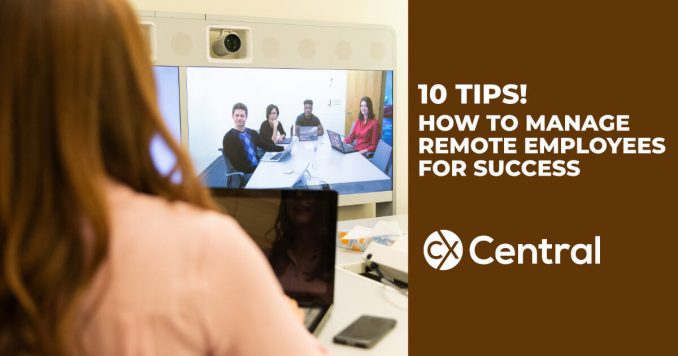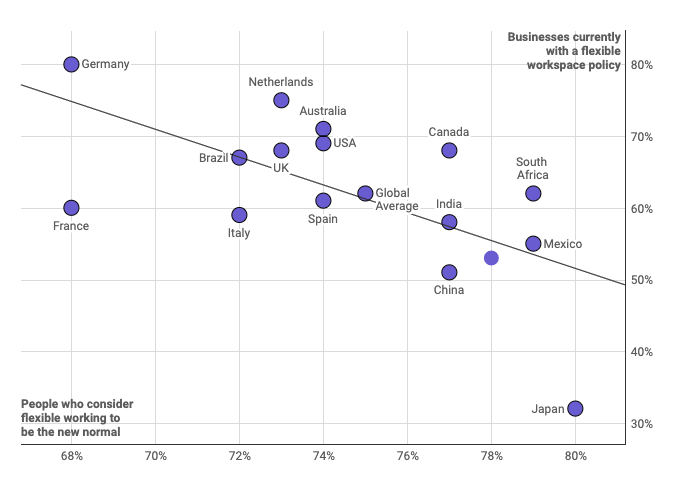
10 Tips for how to Manage Remote Employees
Pre COVID, at least 50% of the current workforce had at least some remote role in their work, according to Global Workplace Analytics.
And, according to the same study, at least 80% of the current workforce would like to work remotely, at least on a part-time basis.
Whether current managers and executives like it or not, even before COVID a new workplace was upon them.
And with COVID, well it simply was no longer a choice or nice-to-have option.
But there is a bright side to all of this.
Research shows that remote workers are actually more productive than those in-house.
In 2019, 71% of Australian businesses reported having a flexible workplace policy and 74% of Australians surveyed consider flexible working to be the new normal. For contact centres specifically, in 2019 around 29% of contact centres offered some work from home capability however during COVID that percentage has increased dramatically.

The challenge, of course, is managing a remote team that may be spread out in many different places is not the same as having everyone in the same location.
Thankfully, technology has given you the means to do this.
It is up to you, now, to use that technology along with your leadership skills, to ensure that your remote team is happy, productive, and contributing to organisational goals.
10 methods to manage remote employees successfully
1. Set Expectations with Clarity
No one is comfortable working under nebulous conditions.
People want to know what needs to be done, how it is to be done, and when it is to be completed.
When you work with remote employees/teams, they must understand your expectations upfront.
2. Communicate Often and Regularly
Your in-house employees have the opportunity to see you on a daily basis.
They can pop into your office, see you in the hallways or at lunch, and can generally keep relationships on-going.
Not so with your remote workers.
You must be as available to them as you are to your in-house staff, and many times you will need to take the initiative to check in with them.
Do this as often as possible.
They need to know you care about how they are doing.
And be certain that you respond immediately to any communications you receive from them.
3. Hold Regularly Scheduled Sessions – Group and Individual
Remote workers who are members of a team need to see you and their teammates often.
Scheduling video-conferencing is a must so that they can all chat together.
They should also have access to one another at all times, even without you.
Individual video sessions are also a must.
Working on projects/tasks is important, of course, but everyone getting to know one another as people is important too.
There is a camaraderie that must be built, so that team members learn to trust one another.
They may want to chat while you are not present – just as your in-house people want to do.
4. Let Them Know You Trust Them
Good leaders do not micro-manage, whether their teams are in-house or remote.
Once task responsibilities and deadlines are assigned, let them go to work.
Remind them that they are available to one another and that you are available to them at any point, should issues arise.
Otherwise, don’t be that supervisor who “hovers.” It sends a message of lack of trust and is harmful to morale.
5. Have the Best Tools
Nothing is more frustrating for remote workers than struggling with downloads, clear conference calls/videos, project management tools, etc.
They need to be able to rely on the digital tools you have provided.
You have sole responsibility for this, so if something is not working well, find another tool that does.
You cannot afford to have frustrated or disgruntled workers simply because the tools are not working well.
They have more important things to do with their time.
6. Have an Agenda for Every Meeting and Allow Time for More
You have a schedule of meetings/conferences. Keep that schedule, but plan ahead and have a set agenda.
Emailing that agenda ahead of time will allow everyone to be prepared and ensure that it runs smoothly.
When things run smoothly, there will be time at the end of the meeting for socialisation.
This is a critical piece, so that remote team members get to know one another at a personal level.
It’s time for workers to announce their personal milestones (marriage, the birth of a baby, a degree earned or a course completed, etc.), to joke, and fill each other in on their lives – things they would do in a traditional workplace environment.
7. Communicate the Organisational Mission Often
It’s easy for in-house employees to have regular reminders of organisational mission and goals – not so with remote employees.
If there are company-wide newsletters and/or memos that report goals met, milestones, department successes, etc., be certain that your remote team receives all of these too.
8. Recognise and Reward
When you manage remote employees or teams they should also be honoured for their accomplishments, just as in-house employees do.
When your team meets a project deadline, it has contributed to the organisation. Be certain that those accomplishments are publicly reported and recognised.
A reward system should be in place as well. And they should be individually-based. Some possibilities include concert tickets, gift or meal certificates, etc. Give your people options from which to choose.
9. Support Career Goals
It is the rare employee who does not have personal career goals.
They want to advance within the company, or they will move on.
If you want to keep your talent, be sure that you know all of their aspirations and provide resources for them to work toward them.
It may be company-sponsored professional development or outside coursework that the organisation should pay for.
When you do these things for your people, you generate loyalty, and they are more willing to wait until that promotion or better position opens up.
It is expensive to replace good employees, so avoid it if you can.
10. Know Individual Strengths and Weaknesses
All people have them – those skills that are amazing and those that are not.
Take the time to identify these and provide the resources and help for those weak areas.
For example, you may have an amazing IT team member who struggles with written reports.
Instead of letting him continue to struggle on his own, find some help.
In the End…
Remote workers are both cost-effective and valuable.
They are highly productive and can have great relationships with one another and their leadership.
As a leader, it is your job to put into place all of those strategies and tools that will develop close relationships, trust, motivation, and those key feelings of belonging that all workers need, whether in-house or remote.
Do these 10 things and you will build a team of remote employees dedicated to your organisation.
Recommended further reading: A guide to call centre work from home models and Tips for managing a contact centre during COVID.
Find solutions to help you manage remote employees including technology suppliers, recruitment agencies, outsourcers and more in the free CX Directory >

